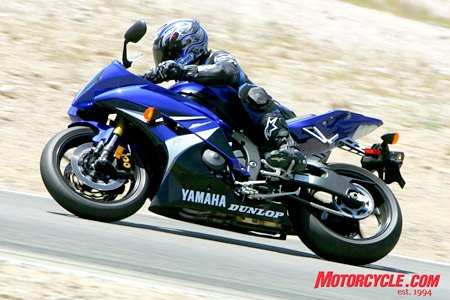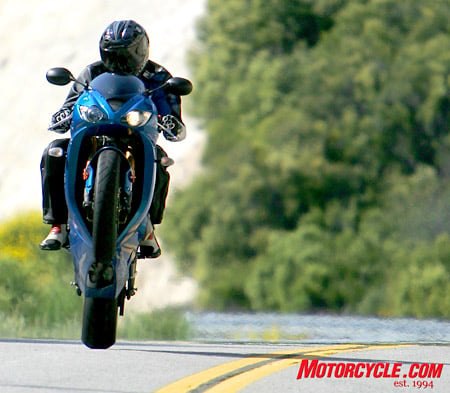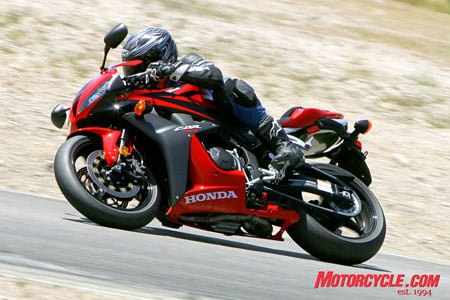Another year, a bigger battle.
With BMW’s S1000RR and KTM’s updated and new-to-the-U.S. RC8R as an all-new model, the field of liter-ish superbikes expands considerably for 2010. Apologies to MV Agusta for not counting the 2010 F4, but no one’s yet signed up to race it in a large-scale series – the KTM was the runner-up in the 2009 IDM (International German Superbike Championship). We sure wouldn’t mind a spin on the MV, though. (Hint, hint, MV Agusta.) Like the race grid, we’ll now expand the roster of contestants in our annual liter test.
No longer limiting the battle to the Big Four from Japan, we’ll eventually include the BMW S1000RR on the list of participants powered by the popular inline-Four configuration. But for now, to start off what has become a literbike mêlée, we’re first evaluating all the Vee configuration contenders.
Wonderful excess!
Not only have we added three new bikes as legitimate contestants, we went one step further and tested the premium models from each brand: the RSV4 Factory from Aprilia, 1198S from Ducati and RC8R from KTM. Both the Aprilia and Duc are suspended (including steering dampers) with Öhlins.
KTM breaks from tradition in the streetbike arena and runs WP suspension all the way ‘round. And it does so in good form, too, as the shock on the RC8R offers easy access to its full adjustability: It smartly employs use of a large, single lock ring for spring preload rather than a pair of locking rings found on so many other shocks.
All three machines bring their high-horsepower antics to a halt with Brembo monobloc calipers up front. And each bike is dressed in various carbon bits, including fenders and subfenders, along with small side panels here and there.
Both Italian models are adorned with magnesium-alloy engine covers for weight savings advantages.
The Aprilia offers three rider-selectable engine modes: (T) Track for unmitigated power, (S) Sport for a mild but notable reduction of power in the first three gears, and (R) Road for considerable neutering of ponies across the board. Mode selection is accessed via the starter button after the bike’s been running for approximately five seconds.
We’ve read where the mapping is supposed to be switchable on the fly, but our experience was that no amount of fiddling with the starter button whilst the bike was in motion would alter the modes, so we attempted changes only while stopped. Even then, figuring out the rhythm was a bit frustrating. Nevertheless, toggling between modes became easier.
Eventually easier, too, was the ability to sense the minor reduction of power in Sport mode. Power reduction in Road mode reminded us of the C mode in the A, B, C settings of Suzuki’s S-DMS (Suzuki Drive Mode Selector). Even a rider newly graduated from the Motorcycle Safety Foundation’s basic rider course could discern the castration of power in Road mode on the Aprilia.
Since 2009 the 1198S offers multi-level (8), rider-selectable traction control. Furthermore, it can be disabled.
In our humble opinions this electronic nanny brings genuine value to the Duc in the form of real-world practicality of electronic wizardry. DTC as found on the 1198S (and not the standard 1198) might just save yo’ ass some day!
Rather than merely scaling back on power at certain throttle openings, gear positions, or all the time, the Duc’s system constantly monitors wheel speeds front and rear, retarding ignition or cutting fueling if the rear wheel spools up quicker than the front.
Although of no benefit to the average owner/rider, the Aprilia has the ability to alter engine and swingarm height as well as repositioning of the headstock to alter steering angle. What the typical Factory owner might more readily appreciate is the bike’s fit ‘n’ finish.
“The Aprilia’s attention to detail is much better than the Ducati and on the level of MV Agusta,” tester Kaming Ko exclaimed.
Small but notable indicators of this are aluminum body panel screws with Aprilia engraved on their heads.
Getting acquainted with the Titans
Ducati race-derived sportbikes can seem committed in riding position, and the 1198 series is no different. Low clip-on placement pulls the rider over the fuel tank in what feels like a long reach to the clip-ons when compared to the Aprilia and KTM.
When immediately switching from the RC8R to the 1198S during our street ride, I couldn’t help but notice how the lowest part of my sternum/upper gut area was pulled into the back of the Duc’s fuel tank. Nothing uncomfortable, but the change in riding position from the more open, upright KTM to race-ready on the Ducati is noticeable.
On the flipside, there’s a surprising amount of room between the Ducati’s seat and footpegs. Dedicated riders or Duc purists could live with the 1198S day in and day out on the street, but it isn’t as friendly as the KTM’s rider triangle.
And on a final Ducati ergo note, guest tester Tom Roderick, as well as Kevin, disliked the less-than-perfect orientation of the rear brake pedal.
“For almost $22,000 I expect a bike to come from the factory with a more ergonomic placement of the rear brake lever instead of feeling like it was mounted as an afterthought,” said Tom.
Before the first outlap of the day at Buttonwillow Raceway in McKittrick, CA, was finished, I was immediately struck with the impression that the Aprilia felt hauntingly familiar. Yeah, that was it! This V-4-powered open-class super stallion felt (and handled!) more like a 600cc supersport than a heftier literbike.
What brought that instant sense of familiarity was a rider triangle reminiscent of the fit of the Honda CBR600RR.
Footpegs are high and rearward, matched by what feels like a short reach to the clip-ons. Since most of the fuel on the Factory is carried below the rider as part of mass-centralization efforts, the fuel tank we see is afforded a smaller shape, therefore the space between the rider and the clip-ons is more open than on the Duc and KTM.
Despite the RSV’s claimed tank capacity of 4.49 gallons, nearly 0.4 more than the Duc and 0.13 more than the KTM, the Priller gets crap fuel economy. On more than one occasion the low-fuel warning light illuminated before reaching the 100-mile mark on a full tank.
Although the KTM provides zero ability for the rider to switch engine mapping, and doesn’t offer up some form of traction control, it does bring an unparalleled amount of rider triangle tuning.
As Kevin informed us in his single-bike review of the RC8R, the Austrian steed offers practical chassis changes, like seat height adjustment via a two-position subframe. And there’s also adjustable footpegs, three-position shift lever linkage (including a relatively easy tweak for GP shift pattern) and a two-position clip-on height adjustment, to name just a couple tunable points.
It’s worth noting that with the subframe in the higher of the two positions, Tom (6’0”) and I (5’8”) often felt like we slid forward into the tank, causing us to put what seemed like an undue amount of weight on both wrists/hands when compared to riding the Aprilia or Ducati. This sensation was most present during canyon carving or when on the track.
Sailing the Super Slab, the KTM’s relaxed rider environment was a welcome break from the 1198S’s racy rider triangle, and the supersport-compact ergos of the RSV4.
"A majority of our test riders gave the KTM the nod for everyday, street-friendly ergos..."
The higher setting on the KTM’s easily adjusted clip-ons creates an open and upright position; just enough windblast at freeway speeds holds the rider up, making for a surprisingly cozy mount. And the RC8R’s seat-to-peg relation was the roomiest of the bunch when its adjustable subframe was in the highest position.
A majority of our test riders gave the KTM the nod for everyday, street-friendly ergos when factoring in its most useful wind protection, best view (more like lesser of three evils!) from the mirrors and least painful seat.
T-Rod (Tom) lauded the KTM for its changeable chassis. “The real world adjustability of the RC8 R is brilliant … making it easy to go from a relaxed street riding position to a more aggressive configuration,” he quipped.
Data from each scoot’s instrument panel is comprehensive.
Ultimately we preferred the RSV4’s mix of an easy-to-read analog tach flanked by an LCD that details everything else.
The 1198S’s dash, if you’re not already familiar with it, is a wide, MotoGP-derived LCD panel that includes a bar graph tachometer. Toggling through the various settings to locate and switch DTC levels with efficiency takes some practice.
The RC8R’s compact panel provides reams of info, too, and the miles per hour reading and bar graph tachometer are simple but effective. Generally, though, the all-in-one panel seems a little too busy for the eyes and mind to sort out while at speed aboard the Austrian superbike.
A feature we like in the KTM’s cockpit is the dedicated Lap button at the rider’s left thumb. When the display is in Road mode the Lap button serves as a toggle to run through the features of the display (Race and Rode modes are for the display only, not engine mapping, etc).
| Suspension: Dialing It In |
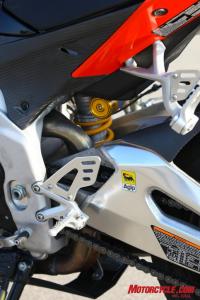 Accessing some of the adjusters on the Aprilia’s shock is downright difficult when compared to reaching to fiddle with the KTM’s WP shock.
Our time at the track reminded us what a treat it is to ride premium suspension and all the variety of settings they provide. But even high-dollar Ohlins and WP components require proper fettling to achieve a setup for a rider’s weight and speed.
After suffering in the first session from suspension too stiff for Buttonwillow’s many bumps, we began wheeling our bikes under the Race Tech canopy for an optimum setup for our riders. Seasoned wrench Lenny Albin was on hand to dial in the bikes, and he quickly spun his wrenches to give us massively improved setups from the way we received the bikes.
We discovered, for our light arses, there’s a whole lotta spring on the shock of each bike here! If you scale in less than, say, 160-ish pounds or aren’t a club racer vying for a class championship, you’ll likely need to consider backing out a few turns of shock preload. Albin also made several key adjustments to the damping circuits to provide compliance with control.
We told Albin that the 1198S steered heavier than the other bikes, and we suggested increasing the rear ride height to achieve a steeper rake angle. But Albin has plenty of experience working on Ducatis, and he instead recommended reducing the height of the rear. Huh?
Albin says the stock 36mm offset triple clamps results in less trail than is ideal, and he has had success in swapping to a 28mm offset triple clamp. Now with more trail to work with, an 1198 can then be tweaked with ride-height adjustments to bring the fork to a steeper and quicker steering rake.
With the stock triple clamps on our bike, the Ducati still required quite a bit of energy to turn in, making for a slightly exhausting ride. But the payoff was stellar handling from just past corner entry all the way through corner exit, with brilliant levels of feel from the Pirelli Diablo Supercorsa up front.
If you’re at a track day, an optimum setup can be worth huge gains in confidence and big chunks in lap times, so the $30 Race Tech fee is a bargain. And the amiable Albin will helpfully debrief a rider afterward, at the ready to improve any setup further. Highly, highly recommended. |
Vee Power
Looking optimistically to dyno charts as a way to appoint one bike as King of the Vees only resulted in further frustration at finding the obvious champ.
The 1198s’s peak hp reading of 147 at 9900 rpm isn’t the loftiest number here, but it’s darn close; and when paired to the highest torque reading of just over 87 ft-lbs at 8K rpm, the Duc’s 90-degree Twin has the strongest combo of peak horsepower and torque.
At 3500 rpm the Ducati’s muscular mill made a solid 20 ft-lbs more than the RSV and 10 more than the KTM at that same point in the revs. However, starting around 4K the Duc’s twisting force takes a dip, by as much as 6 ft-lbs at some points, until around 5500 rpm where it rebuilds quickly toward peak torque only 2500 rpm later.
With 79 ft-lbs at 8200 rpm the KTM doesn’t post 1198-like torque numbers, but what it can claim is the flattest torque curve of the three. Furthermore, the RC8R’s 72-degree V-Twin has essentially matched the 1198S’s torque production by the time the Ducati digs itself out of that little hole mentioned above. At roughly 6500 rpm the big red bike’s engine reveals its strong mid-range, as it finally leapfrogs ahead of the KTM’s torque curve.
The RC8R hangs tough with the Ducati, however, and comes in second place in the horsepower race with just under 149 hp at 10,200 rpm, two more ponies and 300 rpm later than the Duc.
Unfortunately for the KTM, incredibly snatchy fueling detracted severely from enjoyment of the potent Austrian engine.
KTM explained that the current batch of RC8Rs in the press fleet lack a “cam-shaped throttle tube" which they state will come standard on the 2010 production models, and should provide a marked improvement in throttle response. We sincerely hope this is the case, because as is, the fueling overshadows a number of the good things about the Katoom.
Also noteworthy on the KTM was the amount heat from the engine wafting up to the inside of the rider’s legs. We observed this during a cool, December-evening street ride, so we expect the sensation will be worse during summer months.
The KTM isn’t the only hothead here, though.
“An 1198 rider feels a considerable amount of heat coming from the rear cylinder and its header pipe,” Kevin remarked after a long street ride.
After putting all three on the dyno at Carry Andrew’s shop, Hypercycle, the RSV4 Factory took top spot with 150 rear-wheel ponies at 12,300 rpm. Dyno results supported what we discerned at the track: The Aprilia lacks the bottom-end grunt of the Twins but provides inline-Four-like top-end power, evident by explosive acceleration above 10,000 rpm. Hold ‘er steady at that rpm, then slam the throttle open and feel the instant rush of power!
Perhaps, though, what we enjoyed as much as the Aprilia’s power production was the accessibility it granted to all that power.
"...all the test riders fell in love with the manageability of the stupendous spank coming from Aprilia’s V-4."
The Factory has some of the best fuel-injection programming we’ve experienced, especially on such a screamer of an engine. Regardless of the engine’s speed, minute inputs at the twist grip resulted in immediate yet flawless response from the EFI.
In the interest of objectivity we give you dyno results, but it doesn’t take an atomic physicist to realize that it’s basically a dead heat in this department. Be that as it may, all the test riders fell in love with the manageability of the stupendous spank coming from Aprilia’s V-4.
Turn it in, stand it up, go, then stop. Smile and repeat!
The KTM’s light steering effort shone even brighter after suspension tuning. The bike was much more compliant over B-willow's many bumps, and front-end feedback was good but not quite on par with the amount of feel the RSV4 offered.
“Its handling is biased toward its wonderful-feeling front end, encouraging its rider to drop his inside shoulder to carve corners with the trustworthy feel from the Pirelli Supercorsa SP front tire,” said Kevin of the Aprilia’s chassis performance.
Earlier we noted that all three supermachines come equipped with Brembo monobloc calipers. And, really, that’s about all you need to know. However, to make like we’re doing our job, we’ll mention the KTM and Aprilia’s brake levers had more initial travel compared to the Ducati.
Like many things about motorcycles, evaluating braking performance is often a matter of rider preferences. I like the strong initial bite from the Duc’s binders, while Kevin and Kaming were more keen on the softer initial bite (especially for street riding) as found on the other two.
| The Track Club |
By Kevin Duke
We’re continually baffled that so few sportbike riders opt to take their racetrack-bred machines to the wide-open spaces of the track. Despite the easy access to track days across the country, research suggests that less than 10% of sportbikes ever see the track.
To those people, we say you don’t know what you’re missing! The track is a place where the bountiful limits of today’s sportbikes can be explored, allowing riders to brake harder, lean it over farther, and stretch the throttle cables in a way that can’t be safely done on the street. And there’s never any worry of a speeding ticket!
The California area has been ably served for more than a decade by The Track Club. Formerly called Club Desmo in its early days due to its Ducati clientele, TTC caters to all brands and riders. The track-day provider is under the stewardship of Mark Duncan, an avid motorcycle enthusiast who has been producing track days since all the way back in 1994. His event total has now surpassed the 400 mark.
“I have a passion for providing the best track riding experience for everyone attending all of our events,” says Duncan. “They have counted on and trusted us to continue delivering the safest and best run track days that we can.”
These days, the majority of The Track Club events take place at Buttonwillow Raceway, a track just west of Bakersfield, CA, off Interstate 5, and that’s where we recently joined Duncan’s crew. The price for a day at Buttonwillow is so reasonable ($175 on weekends; $150 on weekdays) that even miserly riders won’t have excuses.
Like most track-day organizers, TTC separates riders into three skill levels: Advanced, Intermediate, Novice. We anted up for the Big Dog pass that allows access to any session. Booking consecutive days gets a discount on the cost of the second day.
Not sure if you’re ready for a track day? Then take TTC’s school for new track riders for an extra $100. Riders ready to step up to the next level might want some personal instruction from multi-time World Superbike champ Doug Polen who frequently attends TTC days with his 1On1 Riders School.
Also part of a TTC day are full tire services, including the sales and mounting of Continental’s stickiest tires, both DOT-approved and full slicks. Learn more at SuperbikeTires.net. A nice touch is a dry-erase board with recommended pressures for nearly every brand of tire to suit the day’s track and weather conditions.
For those who want to keep tabs of their progress on track, electronic lap timers are available for $20 and include regular on-site postings as well as printouts at the end of the day. A pro suspension setup from Race Tech costs just $30. Photography services are typically on hand.
We can’t say we enjoy Buttonwillow’s pocked surfaces or the many shiny pavement patches, but we do like the air-conditioned clubhouse and the nearly 1000 sq-ft of canopies TTC sets up over the track at the staging area. Professional corner workers keep on-track action as safe as possible.
Duncan is especially proud of his multi-stage rider/bike recovery team, which he says has resulted in the industry’s best record for keeping an active track. If a rider goes off the track, one of a dozen or so of TTC’s control riders will be on the scene in seconds, followed closely by a dirtbike-mounted responder. If the rider isn’t injured, an ATV/trailer rig can take an infield route to quickly load up the stricken bike. “It allows us to keep the track active, and we are able to address any on-track incident and have it removed and cleaned up in a matter of minutes.”
This wasn’t our first experience with The Track Club, and we were glad to again see a friendly and hospitable staff, a warm and eclectic clientele, and the smoothness of a well-oiled track-day-providing machine that went off from start to finish without a hitch.
“It is important to me,” says the convivial Duncan, “that the customer ends up driving away at the end of the day with an ear-to-ear smile on their face, with worn-down tires, empty fuel cans and that satiated sense of, ‘Man, this was a really great day!’ Then I know that we have done our job.”
Duncan is currently finalizing his schedule for 2010, which will also include four days at the fabulous Laguna Seca circuit for $250 each, plus at least 20 events at Buttonwillow. Check out TheTrackClub.com for the latest information. |
“Which Vee is the best for me?”
Big shocker here (wink), but no one bike says, “Take me and forget the rest!”
At the beginning we lamented how comparing today’s sportbikes is a maddening proposition. Dust off well-worn clichés about “no losers” here.
For a first effort at producing a top-shelf, commercially available superbike, KTM impresses greatly with the RC8R.
Its use of premium WP suspension (owned by KTM) all the way ‘round, heaps of adjustability, and vanguard styling should grab the attention of riders wanting a refreshing change from recent choices in this segment. And The KTM’s Twin is as powerful, for all intents and purposes, as the engines in the Ducati and Aprilia.
However, more vibes make their way to the rider on the RC8R; and although the company says throttle response will be improved on production models, the RC8R’s unrefined fueling was a serious demerit. At $19,998 the KTM is the least expensive of the expensive.
“It's hard to believe a bike this good might not win,” Kevin said about the 1198S after wrapping up a day of laps at Buttonwillow.
Indeed, how does any bike compete against the brand that most folks, riders or not, consider the Ferrari of motorcycles? Hopefully we’ve illustrated that attempting to unseat a Ducati superbike as the highest object of rider lust isn’t an easy thing to do.
With gobs of low- and mid-range power, Öhlins everywhere and the brilliance of rider-manageable traction control, the $21,795 1198S is a dream machine through and through. But when ridden back-to-back against the others, the Duc’s heavy steering effort prevented us from favoring it as the best Vee of the three.
If we had only one word to characterize the RSV4 Factory, it would be the word obedient.
Whether buzzing around on a 125cc scooter or a high-performance sportbike, a machine that does precisely what its rider asks of it is a trait of nearly priceless value. All the more so on a motorcycle with 150 hp at the wheel.
Aprilia has created a spectacular literbike with the overall feel and responsiveness of a 600cc supersport.
The ingenious compactness of its powerful V-4, along with fuel carried below the rider, lends to the Priller's small bike feel. Mix in buttery smooth fueling, telepathic responsiveness from the chassis, an effective slipper clutch and the feature of switchable engine mapping, and we're left to wonder if a rider could ask much more from the $20,999 Aprilia?
If we had our druthers we'd trade switchable engine mapping for some form of genuine traction control. If Ducati can bring that feature and keep the 1198s's MSRP within a stone's throw of the competition, then it seems it possible for other manufacturers to do the same. But playing tit for tat, the Duc doesn’t offer a slipper clutch – an item with plenty of merit in this class considering the level of performance expected from these supreme machines.
With Phase 1 of this year’s liter battle now completed, we'll bide our time as best we can, eagerly anticipating which inline-Four superbike will rise to meet the 2010 Aprilia RSV4 Factory in the last dance of our 2010 Literbike Shootout.
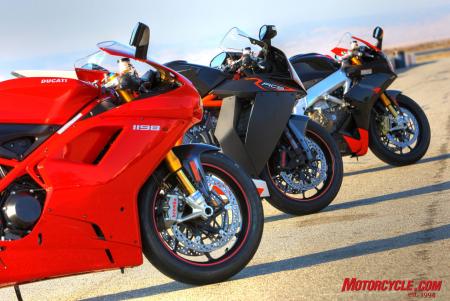 It’s a three-way tug-o-war in the first phase of our annual literbike shootout!
It’s a three-way tug-o-war in the first phase of our annual literbike shootout! 2010 KTM RC8R
2010 KTM RC8R 2010 Ducati 1198S
2010 Ducati 1198S 2010 Aprilia RSV4 Factory
2010 Aprilia RSV4 Factory Accessing some of the adjusters on the Aprilia’s shock is downright difficult when compared to reaching to fiddle with the KTM’s WP shock.
Accessing some of the adjusters on the Aprilia’s shock is downright difficult when compared to reaching to fiddle with the KTM’s WP shock.
 The stump-pulling low- and mid-range power in the Duc’s 90-degree Twin often has the front of the 1198 pawing at the sky.
The stump-pulling low- and mid-range power in the Duc’s 90-degree Twin often has the front of the 1198 pawing at the sky. The Aprilia and KTM have similarly performing chassis, but the RSV4’s slightly more communicative front-end and ultimately stronger motor up top keeps the KTM at bay – but just barely!
The Aprilia and KTM have similarly performing chassis, but the RSV4’s slightly more communicative front-end and ultimately stronger motor up top keeps the KTM at bay – but just barely!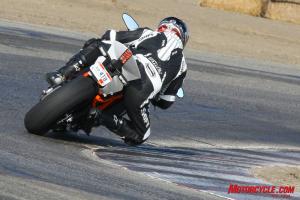

 With nearly 150 rwhp, this is a common occurrence on the RC8R. No one’s complaining though.
With nearly 150 rwhp, this is a common occurrence on the RC8R. No one’s complaining though. The Ducati requires more initial effort to turn, but once in the corner its stability is excellent!
The Ducati requires more initial effort to turn, but once in the corner its stability is excellent!




 Nothing makes the back end of a superbike look as sexy as a single-sided swingarm. Ducati’s been using them for years.
Nothing makes the back end of a superbike look as sexy as a single-sided swingarm. Ducati’s been using them for years. The note coming from the RSV4’s exhaust is intoxicating to the ears of those who love mechanical noises. “If a motorcycle exhaust can sound sexy, this is it. It's like a cross between a GP bike and a V-8 sprint car,” said Kevin.
The note coming from the RSV4’s exhaust is intoxicating to the ears of those who love mechanical noises. “If a motorcycle exhaust can sound sexy, this is it. It's like a cross between a GP bike and a V-8 sprint car,” said Kevin. The RC8R’s footpegs and rear brake pedal peg (as well as the shifter peg) are just a couple examples of the way a rider can adjust the KTM to suit riding style or fit. Note the eccentric on the upper rear of the shock linkage is used for ride-height adjustments. Even more impressive is how easily the shock is accessed.
The RC8R’s footpegs and rear brake pedal peg (as well as the shifter peg) are just a couple examples of the way a rider can adjust the KTM to suit riding style or fit. Note the eccentric on the upper rear of the shock linkage is used for ride-height adjustments. Even more impressive is how easily the shock is accessed. We favored the RSV4 Factory’s analog tach/LCD combo over the LCD-only panels as found on the Ducati and KTM.
We favored the RSV4 Factory’s analog tach/LCD combo over the LCD-only panels as found on the Ducati and KTM.
 The 75-degree V-Twin in the KTM hangs as a stressed member in the trellis frame. The 1198S, like virtually all Ducatis, also uses a steel trellis frame.
The 75-degree V-Twin in the KTM hangs as a stressed member in the trellis frame. The 1198S, like virtually all Ducatis, also uses a steel trellis frame. All three motorcycles utilize Brembo monobloc radial-mount calipers. We like the black color of the calipers as found on the KTM. It’s a cool change from the usual gold or aluminum color.
All three motorcycles utilize Brembo monobloc radial-mount calipers. We like the black color of the calipers as found on the KTM. It’s a cool change from the usual gold or aluminum color.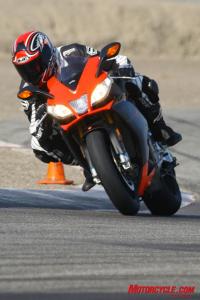 The Factory’s compact overall design makes for a bike that’s comparatively easy to hustle around a racetrack.
The Factory’s compact overall design makes for a bike that’s comparatively easy to hustle around a racetrack.
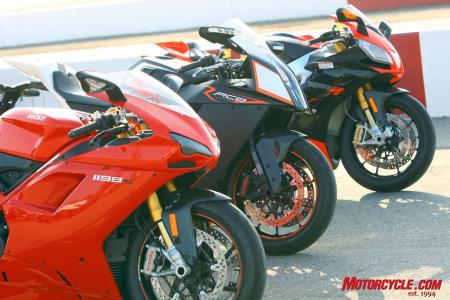 This was a hotly contested battle, with nary a gap between the Duc, KTM and Aprilia. But in the end the RSV4 Factory noses across the line by virtue of its awesome V-4 powerplant wonderfully matched to an equally stellar chassis package.
This was a hotly contested battle, with nary a gap between the Duc, KTM and Aprilia. But in the end the RSV4 Factory noses across the line by virtue of its awesome V-4 powerplant wonderfully matched to an equally stellar chassis package. The new 1198 SP elevates the Ducati experience with a slipper clutch, better suspension and a trick aluminum fuel tank.
The new 1198 SP elevates the Ducati experience with a slipper clutch, better suspension and a trick aluminum fuel tank.
 Wheelies happen without trying on the potent 1198 SP.
Wheelies happen without trying on the potent 1198 SP. Corner entries are made easier on the SP thanks to a slipper clutch that minimizes rear-wheel hop while downshifting.
Corner entries are made easier on the SP thanks to a slipper clutch that minimizes rear-wheel hop while downshifting. The 1198 SP is a regal and raucous red ride.
The 1198 SP is a regal and raucous red ride. Ducati’s traction-control system aids security on corner exits.
Ducati’s traction-control system aids security on corner exits. 


